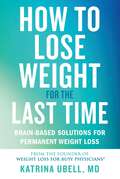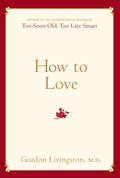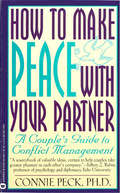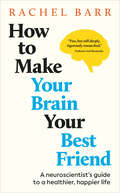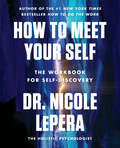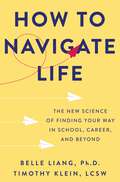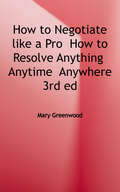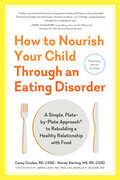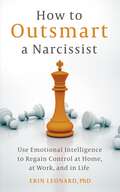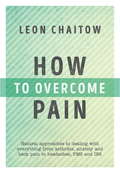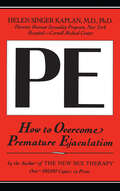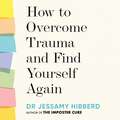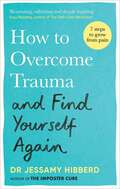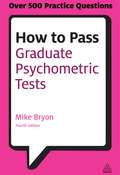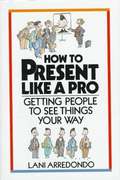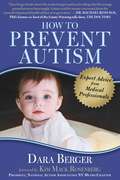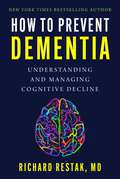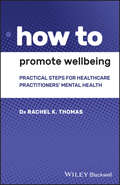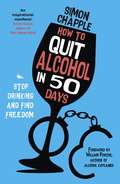- Table View
- List View
How to Lose Weight for the Last Time: Brain-Based Solutions for Permanent Weight Loss
by Katrina UbellThe missing piece to the most sought-after health goal, How to Lose Weight for the Last Time offers brain-based solutions for dropping pounds and keeping them off without suffering or sacrifice. As a pediatrician, Katrina Ubell, MD, always struggled with her weight--she was either 40 pounds overweight, or struggling to lose that weight. Although she'd regularly counsel parents on the importance of keeping their kids healthy and fostering good eating habits, Dr. Ubell, as a busy professional, was never able to do the same for herself. Like everyone else, she tried many different diets and programs, but would always regain the weight. In 2015, Dr. Ubell "cracked the code" for making weight loss permanent, and developed a program targeted at busy physicians like herself who often de-prioritize their own wellness. As a weight loss coach, Dr. Ubell has helped over 1,000 busy physicians and professionals find and stay at a healthy weight with her brain-based program, and is now ready to bring this program to the general public. Dr. Ubell's program doesn't involve any unrealistic diets, plans, special foods, supplements, or even rigorous exercise protocols; instead, she uses a deep understanding of the brain and behavior patterns to get results. Through her work, she has been able to uncover and speak into the universal obstacles that stand in our way of losing and keeping off weight.
How to Love: Choosing Well at Every Stage of Life
by Gordon LivingstonDr. Gordon Livingston-a physician of the human heart, a philosopher of human psychology-offers an urgently needed meditation on who best (and who best not) to love. As in his previous books, Dr. Livingston demonstrates an unerring sense of what is important, providing readers with a much-needed alternative to the trial-and-error learning that makes wisdom such an expensive commodity.
How to Make Peace with Your Partner: A Couple's Guide to Conflict Management
by Connie PeckUse the skills of professional negotiators to solve everyday household issues.
How to Make Your Brain Your Best Friend: A Neuroscientist's Guide to a Healthier, Happier Life
by Rachel BarrYour brain is the most remarkable thing in the known universe.Fun, but still deeply, rigorously researched.' - Professor Neil Shyminsky'A true masterpiece. Rachel Barr has done a phenomenal job breaking down the complexities of the human mind.' - Jeffrey Meltzer, LMHC'Insightful and relatable psychoeducation that demystifies the brain . . . it&’s a resource I&’ll proudly keep on my shelf as a therapist.' - Joshua Fletcher, anxiety therapistAlways trying to mend itself, and always trying to protect you, it&’s in a constant state of flux — adapting, reconfiguring, finding new pathways . . . And it has an astonishing capacity for recovery.Only it doesn&’t always get it right.Rachel Barr struggled through years of devastating loss, heartache, and uncertainty until neuroscience gave her the first spark of self-belief she had felt in her adult life — and proof that, because of the brain&’s near-infinite potential for neuroplastic change, it&’s never too late to carve out neural pathways to form new habits, new skills, and new ways of thinking.Whether you want to nerd-out on Neuroscientific acronyms, finally understand what&’s going on in your head, or take refuge in a book that&’s like a warm hug for your mind, How to Make Your Brain Your Best Friend is a delight-filled, evidence-based guide to taking better care of your brain — so it, in turn, will take better care of you.
How to Meet Your Self: The Workbook For Self-discovery
by Dr. Nicole LePeraFrom Dr. Nicole LePera, author of the #1 New York Times bestseller How to Do the Work, comes an interactive workbook offering a practical roadmap for self-healing.At the root of all healing work is awakening consciousness, a process of shining light into the darkness of the unknown. In recent years, Dr. Nicole LePera has become the leading voice in psychological self-healing, helping millions of people around the world rise out of survival mode to consciously create authentic lives they love.In her first book, How to Do the Work, Dr. Nicole offered readers a revolutionary, holistic framework for self-healing. Now, in How to Meet Your Self, she shares an interactive workbook designed to help every reader uncover their Authentic Self. By objectively and compassionately observing the physical, mental, and emotional patterns that fill our days and create our current selves, we can more clearly see what we do not wish to carry into the future.We all fall into conditioned habits and patterns—products of our past—that lead to cycles of pain, stuckness, and self-destruction. But as Dr. Nicole shares, we also have the innate ability to awaken to and change the behaviors and habits that no longer serve us, allowing us to step into the highest versions of ourselves. And as you work through this book and witness these default habits, from sleep to movement to eating, through emotional reactivity and core beliefs, you will never again have to ask: “but where do I start?”How to Meet Your Self is a revolutionary guide, a kind and encouraging companion, and a comprehensive masterwork of self-understanding that will radically transform your inner work and outer world.
How to Mix Methods: A Guide to Sequential, Convergent, and Experimental Research Designs
by Jen Katz-BuonincontroThis book shows researchers in education, psychology, health, and other social sciences how to mix qualitative and quantitative research methods together with confidence. How can researchers sequence and incorporate data in ways that are meaningful, without simply combining data and hoping it makes sense? This book walks readers through the essential steps to avoid some common mistakes and to clarify confusing parts of common method designs. It offers a series of "how-to" steps, situated within the core mixed methods designs. Students and researchers will learn the 10 essential design elements of all mixed methods research, how to clearly distinguish between the different core mixed methods designs, how to figure out which design works best for their research, and more.
How to Navigate Life: The New Science of Finding Your Way in School, Career, and Beyond
by Belle Liang PhD Timothy Klein LCSWAn essential guide to tackling what students, families, and educators can do now to cut through stress and performance pressure, and find a path to purpose.Today’s college-bound kids are stressed, anxious, and navigating demands in their lives unimaginable to a previous generation. They’re performance machines, hitting the benchmarks they’re “supposed” to in order to reach the next tier of a relentless ladder. Then, their mental and physical exhaustion carries over right into first jobs. What have traditionally been considered the best years of life have become the beaten-down years of life. Belle Liang and Timothy Klein devote their careers both to counseling individual students and to cutting through the daily pressures to show a better way, a framework, and set of questions to find kids’ “true north”: what really turns them on in life, and how to harness the core qualities that reveal, allowing them to choose a course of study, a college, and a career. Even the gentlest parents and teachers tend to play into pervasive societal pressure for students to PERFORM. And when we take the foot off the gas, we beg the kids to just figure out what their PASSION is. Neither is a recipe for mental or physical health, or, ironically, for performance or passion. How to Navigate Life shows that successful human beings instead tap into their PURPOSE—the why behind the what and how. Best of all, purpose is a completely translatable quality to every aspect of life, from first jobs to last jobs and everything in between.
How to Negotiate Like a Pro: How to Resolve Anything, Anytime, Anywhere
by Mary GreenwoodIf you can't seem to get what you want, it's time to learn how to negotiate like a pro. <p><p>In this third revised and updated edition of How to Negotiate like a Pro: How to Resolve Anything, Anytime, Anywhere (the first two editions won nine book awards), Greenwood, with over 30 years of experience, has added a new chapter on How to Negotiate with Difficult People, including pathological liars, narcissists, and bullies. <p><p>Here is a sample of tips you will learn: --Gain strategies and practical tips for the negotiation process --Learn what makes a good negotiator --Close the deal --Strategize how to win with a narcissist --Learn the ten questions to get the best deal --Find out how to get the best salary and not leave money on the table. After reading Greenwood's 41 rules, you will soon be negotiating like a pro.
How to Not Die Alone: The Surprising Science That Will Help You Find Love
by Logan UryA &“must-read&” (The Washington Post) funny and practical guide to help you find, build, and keep the relationship of your dreams—from the Harvard-trained behavioral scientist and featured dating coach on Netflix&’s The Later Daters.Have you ever looked around and wondered, &“Why has everyone found love except me?&” You&’re not the only one. Great relationships don&’t just appear in our lives—they&’re the culmination of a series of decisions, including whom to date, how to end it with the wrong person, and when to commit to the right one. But our brains often get in the way. We make poor decisions, which thwart us on our quest to find lasting love. Drawing from years of research, behavioral scientist turned dating coach Logan Ury reveals the hidden forces that cause those mistakes. But awareness on its own doesn&’t lead to results. You have to actually change your behavior. Ury shows you how. This &“simple-to-use guide&” (Lori Gottlieb, New York Times bestselling author of Maybe You Should Talk to Someone) focuses on a different decision in each chapter, incorporating insights from behavioral science, original research, and real-life stories. You&’ll learn: -What&’s holding you back in dating (and how to break the pattern) -What really matters in a long-term partner (and what really doesn&’t) -How to overcome the perils of online dating (and make the apps work for you) -How to meet more people in real life (while doing activities you love) -How to make dates fun again (so they stop feeling like job interviews) -Why &“the spark&” is a myth (but you&’ll find love anyway) This &“data-driven&” (Time), step-by-step guide to relationships, complete with hands-on exercises, is designed to transform your life. How to Not Die Alone will help you find, build, and keep the relationship of your dreams.
How to Nourish Your Child Through an Eating Disorder: A Simple, Plate-by-plate Approach® To Rebuilding A Healthy Relationship With Food
by Wendy Sterling Casey CrosbieA revolutionary, entirely visual approach to helping your child overcome their eating disorder (ED) and eat normally again that does away with counting calories and measuring food—rooted in the leading evidence-based approach: Family-Based Therapy (FBT) Parents are the first to know when their child starts behaving differently. Has your son stopped eating his favorite food, or does he refuse to eat out with friends? Has your daughter drastically increased her exercise regimen, or become obsessed with health foods? These are among the telltale signs that your child, like millions of others, may have an eating disorder (ED). In this essential guide, registered dietitians Casey Crosbie and Wendy Sterling introduce an all-new strategy you can use to help your child at home. The Plate-by-Plate approach is rooted in family-based treatment (FBT)—the leading psychological therapy for EDs. Unlike complicated “exchange” systems, this is simple: Crosbie and Sterling coach you through every aspect of meeting your child’s nutritional needs, using just one tool—a ten-inch plate. Paired with therapy, this intuitive, visual method is the best way to support your child on the path to recovery. Plus, the authors cover how to talk about diet and weight, what to do while traveling, what to expect from your child’s doctor, and much more.
How to Nourish Yourself Through an Eating Disorder: Recovery For Adults With The Plate-by-plate Approach®
by Wendy Sterling Casey CrosbieOvercome your eating disorder and repair your relationship with food, starting today If you struggle with anorexia, bulimia, binge eating, or another form of disordered eating, the path to normal eating may seem impossible. This is why Wendy Sterling and Casey Crosbie created the Plate-by-Plate Approach®: a simple, numberless, exchange-free program to restore your relationship with food. In this practical, easy-to-use guide—complete with sample plates, example schedules, and helpful tracking logs—they teach you to take control of your nutrition with nothing more than a 10-inch plate. Learn to use the Plate-by-Plate Approach® at home. Understand common patterns and behaviors to restore your relationship with food. Adapt the Plate-by-Plate Approach® to your own dietary and cultural needs. Overcome common barriers on your journey to healthy eating. How to Nourish Yourself Through an Eating Disorder transforms the challenging path to recovery, simplifying your treatment plan and provide a straightforward, intuitive, tried-and-true method for a better life.
How to Outsmart a Narcissist: Use Emotional Intelligence to Regain Control at Home, at Work, and in Life
by Erin LeonardIt might be surprising to learn that the emotional qualities that allow you to remain close to others, empathize, collaborate, compromise, perspective-take, and easily resolve conflict, in most healthy relationships, can actually backfire with a narcissist.Why? Because you see the good. You trust. You empathize. These emotionally intelligent attributes keep you connected to others and help you resolve conflict amicably and maintain healthy relationships.Written by psychotherapist and attachment expert, Dr. Erin Leonard, How to Outsmart a Narcissist breaks down how a narcissist manipulates and exploits these traits and details strategies to protect yourself against their attacks, whether they come from a romantic partner, a work colleague, a spouse, a co-parent, or a family member.Filled with relatable stories, emotionally intelligent solutions, and practical advice to help you outsmart the narcissist in your life, this is your guide to finally finding peace from their chaos.
How to Outsmart a Narcissist: Use Emotional Intelligence to Regain Control at Home, at Work, and in Life
by Erin LeonardIt might be surprising to learn that the emotional qualities that allow you to remain close to others, empathize, collaborate, compromise, perspective-take, and easily resolve conflict, in most healthy relationships, can actually backfire with a narcissist.Why? Because you see the good. You trust. You empathize. These emotionally intelligent attributes keep you connected to others and help you resolve conflict amicably and maintain healthy relationships.Written by psychotherapist and attachment expert, Dr. Erin Leonard, How to Outsmart a Narcissist breaks down how a narcissist manipulates and exploits these traits and details strategies to protect yourself against their attacks, whether they come from a romantic partner, a work colleague, a spouse, a co-parent, or a family member.Filled with relatable stories, emotionally intelligent solutions, and practical advice to help you outsmart the narcissist in your life, this is your guide to finally finding peace from their chaos.
How to Overcome Pain: Natural Approaches to Dealing with Everything from Arthritis, Anxiety and Back Pain to Headaches, PMS, and IBS
by Leon ChaitowLiving with pain can provoke frustration, anxiety, depression and sometimes even a reliance on pharmaceutical painkillers. In this important and highly accessible book, registered osteopath and naturopath Leon Chaitow outlines a wide range of tried and tested natural approaches to pain relief, as well as groundbreaking research including the role played by fascia in the experience of pain and a whole host of breakthrough mind-body techniques. The author begins by explaining the nature of pain and why it is that the more you understand about it, the greater an ability you tend to have to overcome it. He then goes on to outline key pain relief approaches including meditation, hypnotherapy, cognitive behavioural therapy, light and colour therapy, breathing techniques, massage, stretching, hydrotherapy and herbalism. There is also extensive information on the importance of nutrition and supplements. And a special feature is the extensive pain directory that provides treatment advice for the most common problems including headaches, neck and shoulder pain, and backache. Featuring step-by-step self-help exercises and occasional helpful diagrams, this is an essential book for everyone wanting to take control of pain, get their health and vitality back, and enhance their sense of comfort, ease and freedom in everyday life.
How to Overcome Premature Ejaculation
by Helen Singer KaplanHow to Overcome Premature Ejaculation discusses male sexual response and the cause of its disorders, and provides advice on leading a more normal sex life. Based on the same therapeutic methods that have proven clinically effective for 90% of men suffering from premature ejaculation (PE), this straightforward volume describes a rapid, practical self-help program that can be used by single men or couples in the privacy of their home. Dr Kaplan first explains the nature of PE and its causes and then describes her effective treatment techniques. She also discusses the errors and resistances that can arise and provides suggestions on how to overcome them.
How to Overcome Trauma and Find Yourself Again: Seven Steps to Grow from Pain
by Dr Jessamy HibberdFREE YOURSELF FROM PAIN, UNDERSTAND YOUR TRAUMA AND FIND INNER PEACE IN THIS LIFE-CHANGING GUIDE, FROM THE AUTHOR OF THE IMPOSTER CURESo many of us experience trauma throughout our lives. Trauma can be debilitating. Left unaddressed, it can have a long-term impact on our physical, mental and emotional health, restricting our personal growth and leaving us feeling empty and unfulfilled.In this book Dr Jessamy unriddles the effects of trauma. Using a combination of psychology, neuroscience and her own experiences, Dr Jessamy brings a tough subject to life and opens up the space for healing. This book centres on the concept of 'Post-traumatic growth' - a term used to describe the remarkable way that painful experiences can lead to a valuable re-assessment of life, a renewed discovery of meaning and a fresh perspective.Through her programme, readers will learn how to process past events and move forward with greater purpose and self-acceptance. Dr Jessamy examines common trauma responses and provides us with the building blocks to make sense of our pain in order to reach a deeper level of self-awareness and appreciation. UltimatelyDr Jessamy will help you find meaning when life feels meaningless and remain hopeful even in the face of adversity.PRAISE FOR THE IMPOSTER CURE:'You've definitely heard of it, you've almost certainly felt it and it's actively stopping you from being your best self. In a new book on imposter syndrome Dr Jessamy Hibberd provides a definitive guide to understanding and tackling the psychological mind trap. - The Sunday Times(p) 2023 Octopus Publishing Group
How to Overcome Trauma and Find Yourself Again: Seven Steps to Grow from Pain
by Dr Jessamy Hibberd"Reassuring, validating and deeply inspiring" - Suzy Reading, bestselling author of The Self-Care Revolution"Compassionate wisdom in an easy to use format to help you build back and grow after trauma" - Dr Emma Hepburn, clinical psychologist, author of A Toolkit For Your Emotions"Reading this book will heal what happened to you" - Dr Martha Deiros Collado, clinical psychologistFREE YOURSELF FROM PAIN, UNDERSTAND YOUR TRAUMA AND FIND INNER PEACE IN THIS LIFE-CHANGING GUIDE, FROM THE AUTHOR OF THE IMPOSTER CURESo many of us experience trauma throughout our lives. Left unaddressed, it can have a long-term impact on our physical, mental and emotional health, restricting our personal growth and leaving us feeling empty and unwell.In this book, Dr Jessamy Hibberd unriddles the effects of trauma. Using a combination of psychology, neuroscience and her own experiences as a chartered psychologist treating people with trauma, Dr Hibberd unpacks a tough subject and opens up the space for self-healing. This book centres on the concept of 'post-traumatic growth', a term used to describe the remarkable way that painful experiences can lead to a valuable reassessment of life and a newfound discovery of meaning.Through her revolutionary, seven-step programme, readers will learn how to process past events and move forward with a deeper level of self-awareness, a greater sense of purpose, and a renewed self-acceptance. Grounded in research and brought to life with real stories, How to Overcome Trauma and Find Yourself Again will give you the tools to move beyond the hurt and lead a more fulfilling, joyful life.PRAISE FOR THE IMPOSTER CURE:'You've definitely heard of it, you've almost certainly felt it and it's actively stopping you from being your best self. In a new book on imposter syndrome Dr Jessamy Hibberd provides a definitive guide to understanding and tackling the psychological mind trap. - The Sunday Times
How to Overcome Trauma and Find Yourself Again: Seven Steps to Grow from Pain
by Dr Jessamy Hibberd"Reassuring, validating and deeply inspiring" - Suzy Reading, bestselling author of The Self-Care Revolution"Compassionate wisdom in an easy to use format to help you build back and grow after trauma" - Dr Emma Hepburn, clinical psychologist, author of A Toolkit For Your Emotions"Reading this book will heal what happened to you" - Dr Martha Deiros Collado, clinical psychologistFREE YOURSELF FROM PAIN, UNDERSTAND YOUR TRAUMA AND FIND INNER PEACE IN THIS LIFE-CHANGING GUIDE, FROM THE AUTHOR OF THE IMPOSTER CURESo many of us experience trauma throughout our lives. Left unaddressed, it can have a long-term impact on our physical, mental and emotional health, restricting our personal growth and leaving us feeling empty and unwell.In this book, Dr Jessamy Hibberd unriddles the effects of trauma. Using a combination of psychology, neuroscience and her own experiences as a chartered psychologist treating people with trauma, Dr Hibberd unpacks a tough subject and opens up the space for self-healing. This book centres on the concept of 'post-traumatic growth', a term used to describe the remarkable way that painful experiences can lead to a valuable reassessment of life and a newfound discovery of meaning.Through her revolutionary, seven-step programme, readers will learn how to process past events and move forward with a deeper level of self-awareness, a greater sense of purpose, and a renewed self-acceptance. Grounded in research and brought to life with real stories, How to Overcome Trauma and Find Yourself Again will give you the tools to move beyond the hurt and lead a more fulfilling, joyful life.PRAISE FOR THE IMPOSTER CURE:'You've definitely heard of it, you've almost certainly felt it and it's actively stopping you from being your best self. In a new book on imposter syndrome Dr Jessamy Hibberd provides a definitive guide to understanding and tackling the psychological mind trap. - The Sunday Times
How to Pass Graduate Psychometric Tests
by Mike BryonHow to Pass Graduate Psychometric Tests provides a huge bank of questions as well as advice and practice exercises to help you prepare for the rigorous tests used by employers, helping you to build up speed, accuracy and confidence. Covering a range of numerical and verbal skills, it provides 500 practice questions, including 10 realistic full length practice tests; a glossary of essential terms in English usage; a glossary of key mathematical terms and methods; study tips and winning test strategies; answers, explanations and interpretations of your scores. With information on what to expect when attending an assessment centre and detailed advice on how to excel in each activity, How to Pass Graduate Psychometric Tests provides unrivalled support to help you to succeed and win that graduate job.
How to Present Like a Pro: Getting People to See Things Your Way
by Lani ArredondoA short and concise guide to making a memorable and effective presentation.
How to Prevent Autism: Expert Advice from Medical Professionals
by Scott Smith Katie Wright James Lyons-Weiler Kim Mack Rosenberg Dara Berger Dr Sidney Baker Dr Nancy O'Hara Geri Brewster Maureen McDonnel Dr Anju Usman Dr Stephanie Seneff Maria Rickert-Hong Corinne Simpson BrownThe statistics are alarming and become more so every year. The Centers for Disease Control and Prevention estimates that 1 in 68 children have been identified with an autism spectrum disorder, making it one of the fastest growing developmental disorders in the United States. Further, the CDC estimates that parents with a child on the autism spectrum can have nearly a 20 percent chance of having a second child with autism.In How to Prevent Autism, Dara Berger shares her personal journey with autism. She describes everything that went wrong with her son that led to an autism diagnosis and everything she did differently to prevent her daughter from suffering the same fate. She interviews eight well-known ASD experts--including doctors, nutritionists, nurses, and scientists--about the factors that have led to the growing epidemic of autism. Based on the best practices for preventing autism in children, each professional offers perspectives grounded in their own research and their patients’ improvements. The book covers every detail--from the importance of mothers’ cleaning out their bodies preconception, through common genetic mutations that may put children at risk, to the crucial role of nutrition in prevention.All parents agree that every choice counts when it comes to the health of their children. As Dara Berger makes clear in this personal, informative, and authoritative book, the stakes could not be higher when it comes to autism.
How to Prevent Dementia: Understanding and Managing Cognitive Decline
by Richard RestakA comprehensive guide to preventing Alzheimer&’s and other thinking disorders from bestselling author and renowned authority Dr. Richard Restak!How to Prevent Dementia begins with the principle that the more we know about dementia, the easier it is to prevent or delay it. A better foundation of knowledge also helps people to understand and interact thoughtfully with family members and other loved ones who may have Alzheimer&’s and other dementias. Dr. Restak examines the basic thinking of normal everyday people and progresses to people with thinking disorders. In understanding that dementias exist along a continuum, starting with perfectly normal performance and ending at the extremes of mental dysfunction, we learn how our attention to everyday habits, choices, and behaviors can affect where we are located along that continuum, as well as whether or how we will progress from one part to another. As can be gleaned from recent reports, researchers may be on the cusp of a meaningful treatment or cure for Alzheimer&’s. Dr. Restak also helps the reader to grasp both the positive and challenging consequences of the new medications that will soon be available. At the end of the book, the reader will understand what practical steps can be taken each day to lessen the odds of dementia and how to take advantage of new medications, while gaining a better understanding of thinking and what it is like to have it falter.
How to Promote Wellbeing: Practical Steps for Healthcare Practitioners' Mental Health (How To)
by Rachel K. ThomasHow to Promote Wellbeing is a timely resource designed to help all healthcare practitioners promote and protect their own and their patients’ wellbeing and mental health. Focusing on practical strategies and guidance, this much-needed book explores approaches for reducing burnout, managing stress, coping with pressure in healthcare settings, recognising signs of impaired decision-making, and much more. Written specifically for busy healthcare practitioners, the book offers focused and succinct chapters on topics ranging from behaviours to improve resilience and mindfulness, to approaches for maintaining work-life balance when confronted with excessive workloads and organisational pressures. Throughout the text, evidence-based tools and techniques are provided to improve the practitioner’s health and facilitate the delivery of high-quality care. Covering a wide range of clinical situations and important issues, this book: Examines global, organisational, and individual problem factors affecting mental health and wellbeing Discusses the impacts of chronic stress, burnout, technological and environmental factors, work-associated trauma, and sources of wellbeing strain Identifies factors that negatively affect patients’ wellbeing in hospital, clinic, and outpatient settings Offers guidance for emergencies and available resources for those in personal crisis Includes a mental health and wellbeing toolkit, including assessments and strategies How to Promote Wellbeing is indispensable reading for doctors, nurses, dentists, therapists, counsellors, and other clinicians and health professionals.
How to Quit Alcohol in 50 Days: Stop Drinking and Find Freedom
by Simon Chapple'AN INSPIRATIONAL MANIFESTO' - Annie Grace'SIMON IS FABULOUS - YOU HAVE NOTHING TO LOSE AND EVERYTHING TO GAIN!' - Clare PooleyDo you feel trapped by alcohol? Do you find yourself thinking about drinking too often? Do you put alcohol ahead of the most important things in your life? If so - here's some good news. You can quit drinking, and it's not as difficult as you think.Simon Chapple is a Certified Alcohol Coach who has helped thousands of people change the way that alcohol features in their lives. In How to Quit Drinking in 50 Days he'll give you a structured way to find complete freedom from alcohol - for now, or forever.This 50-day journey to freedom is split into two parts. Days 1-25 will ask you to take an honest look at the impact alcohol has had on your life, to examine the reasons for your drinking, and will arm you with the best strategy for quitting alcohol successfully. Days 26-50 will ask you to make the commitment to taking a break from alcohol - taking each step with one chapter a day, and answering the questions that come up.There are strategies for dealing with challenges and setbacks, and a wealth of resources for finding support and inspiration. Above all, there is a genuine passion for the sober adventure, and the huge rewards of an alcohol-free life - a life of freedom that's waiting for you.*Includes free downloadable workbook and journal* Download the workbook from the John Murray Learning Library website, or the free John Murray Learning app. PREORDERED? VISIT SIMON'S 'BE SOBER' WEBSITE TO CLAIM YOUR PLACE ON AN EXCLUSIVE WORKSHOP
How to Quit Alcohol in 50 Days: Stop Drinking and Find Freedom
by Simon Chapple'AN INSPIRATIONAL MANIFESTO' - Annie Grace'SIMON IS FABULOUS - YOU HAVE NOTHING TO LOSE AND EVERYTHING TO GAIN!' - Clare PooleyDo you feel trapped by alcohol? Do you find yourself thinking about drinking too often? Do you put alcohol ahead of the most important things in your life? If so - here's some good news. You can quit drinking, and it's not as difficult as you think.Simon Chapple is a Certified Alcohol Coach who has helped thousands of people change the way that alcohol features in their lives. In How to Quit Drinking in 50 Days he'll give you a structured way to find complete freedom from alcohol - for now, or forever.This 50-day journey to freedom is split into two parts. Days 1-25 will ask you to take an honest look at the impact alcohol has had on your life, to examine the reasons for your drinking, and will arm you with the best strategy for quitting alcohol successfully. Days 26-50 will ask you to make the commitment to taking a break from alcohol - taking each step with one chapter a day, and answering the questions that come up.There are strategies for dealing with challenges and setbacks, and a wealth of resources for finding support and inspiration. Above all, there is a genuine passion for the sober adventure, and the huge rewards of an alcohol-free life - a life of freedom that's waiting for you.*Includes free downloadable workbook and journal* Download the workbook from the John Murray Learning Library website, or the free John Murray Learning app. PREORDERED? VISIT SIMON'S 'BE SOBER' WEBSITE TO CLAIM YOUR PLACE ON AN EXCLUSIVE WORKSHOP
